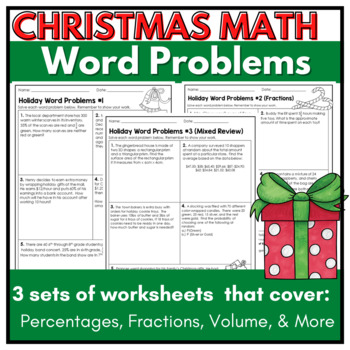Christmas Math Word Problems
The Positive Math Classroom by Amy Hearne
2.3k Followers
Grade Levels
6th - 8th, Homeschool
Subjects
Resource Type
Standards
CCSS7.G.B.6
CCSS7.SP.C.5
CCSS6.NS.A.1
CCSS7.EE.B.3
CCSS7.RP.A.1
Formats Included
- PDF
Pages
10 pages
The Positive Math Classroom by Amy Hearne
2.3k Followers
Also included in
- Engage your students during the busiest time of the year with these holiday themed math worksheets. Not only is this bundle perfect for the Christmas season, but also includes practice with important math skills including solving equations, simplifying expressions, calculating percents, fraction opePrice $14.75Original Price $21.20Save $6.45
Description
Print and go with this set of holiday math word problem worksheets. Not only are they great for reviewing a variety of concepts including percentages and fraction operations, but they are especially helpful during the busiest time of the year.
Included are three sets of worksheets that include:
- Percentage Word Problems
- Fraction Operation Word Problems
- Mixed Review Word Problems
An answer key is also included with your purchase.
You may also be interested in these other resources from my shop:
*Click here to follow me for updates on new products that are always 50% off for the first 24 hours!
Total Pages
10 pages
Answer Key
Included
Teaching Duration
N/A
Report this resource to TPT
Reported resources will be reviewed by our team. Report this resource to let us know if this resource violates TPT’s content guidelines.
Standards
to see state-specific standards (only available in the US).
CCSS7.G.B.6
Solve real-world and mathematical problems involving area, volume and surface area of two- and three-dimensional objects composed of triangles, quadrilaterals, polygons, cubes, and right prisms.
CCSS7.SP.C.5
Understand that the probability of a chance event is a number between 0 and 1 that expresses the likelihood of the event occurring. Larger numbers indicate greater likelihood. A probability near 0 indicates an unlikely event, a probability around 1/2 indicates an event that is neither unlikely nor likely, and a probability near 1 indicates a likely event.
CCSS6.NS.A.1
Interpret and compute quotients of fractions, and solve word problems involving division of fractions by fractions, e.g., by using visual fraction models and equations to represent the problem. For example, create a story context for (2/3) ÷ (3/4) and use a visual fraction model to show the quotient; use the relationship between multiplication and division to explain that (2/3) ÷ (3/4) = 8/9 because 3/4 of 8/9 is 2/3. (In general, (𝘢/𝘣) ÷ (𝘤/𝘥) = 𝘢𝘥/𝘣𝘤.) How much chocolate will each person get if 3 people share 1/2 lb of chocolate equally? How many 3/4-cup servings are in 2/3 of a cup of yogurt? How wide is a rectangular strip of land with length 3/4 mi and area 1/2 square mi?
CCSS7.EE.B.3
Solve multi-step real-life and mathematical problems posed with positive and negative rational numbers in any form (whole numbers, fractions, and decimals), using tools strategically. Apply properties of operations to calculate with numbers in any form; convert between forms as appropriate; and assess the reasonableness of answers using mental computation and estimation strategies. For example: If a woman making $25 an hour gets a 10% raise, she will make an additional 1/10 of her salary an hour, or $2.50, for a new salary of $27.50. If you want to place a towel bar 9 3/4 inches long in the center of a door that is 27 1/2 inches wide, you will need to place the bar about 9 inches from each edge; this estimate can be used as a check on the exact computation.
CCSS7.RP.A.1
Compute unit rates associated with ratios of fractions, including ratios of lengths, areas and other quantities measured in like or different units. For example, if a person walks 1/2 mile in each 1/4 hour, compute the unit rate as the complex fraction ½/¼ miles per hour, equivalently 2 miles per hour.






